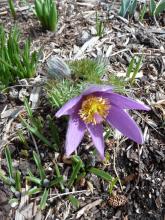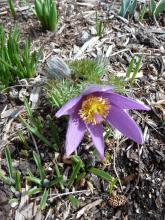Pulsatilla halleri ssp. slavica 'Alba', started from NARGS seed in 2009, will bloom this year:
The first of the Pulsatilla vulgaris are blooming... funny how the younger plants seem to start blooming earlier than the older plants:

Pulsatilla patens blooming in the front yard... I'm not certain if this is a plant I bought long ago that is finally blooming, or if it is one of the seedlings from 2 years ago:

They are blooming in the wild now too - I'll follow up with some pictures!
Comments
Re: Pulsatilla 2012
The Plant List also considers Pulsatilla occidentalis to be a synonym of Anemone occidentalis. I gather there must be some reason to deny North America it's pulsatilla species, though I have no idea what it is. ???
Re: Pulsatilla 2012
They are beautiful whatever the name be!
Re: Pulsatilla 2012
I wouldn't know! But it is lovely anyway.
Re: Pulsatilla 2012
Remember this posting of mine a couple years ago? (I basically asked the same thing.)
http://nargs.org/smf/index.php?topic=56.msg1282#msg1282
I also looked quite a few postings of halleri on the SRGC. None of them even had as much leaves during flowering as yours, Lori (and way less than mine).
Re: Pulsatilla 2012
Love them all! I was very disappointed to see rodent damage (two holes coming out of the soil,, near/right where the Pulsas were) in the bed with my P vulgaris plants which had been getting nice and big- I think both large plants are gone, and all I see is one small plant, probably one of the self sown seedlings..
Weirdly, the bulbs- some retic Iris, Scilla, not sure if Muscari is up seem to be okay, and are actually doing better than last year, when I thought they were dying out in the bed (presumably since I realised the bed was in the path of meltwater-I made it wider so the water can flower outside of the planted area)..
Of course, it could be something else that killed the Pulsas, but seems a bit coincidental...
Lori/others do you do anything particular with the soil for most Pulsa sp?
Re: Pulsatilla 2012
Ah, right, I forgot about that, Rick. My plant has a little different appearance than my many P. vulgaris... wonder what it is.
Cohan, pulsatillas are very tolerant of the conditions here and don't seem to require any special soil... well, actually, nothing in my yard gets special soil, other than alpines that I think will actually need it... and a few of the things in the acid beds.
Re: Pulsatilla 2012
That's why I was wondering about the Pulsatillas- some of them are alpines ;D
My property does have at least two completely different dynamics, though- the drier greyer soil end, and the moister blacker end, and I'm doing plantings at both ends (plus areas on sunny sides of spruce trees in the drier part of the yard, which are drier still).. so I have to choose which spots are better for various plants-- some I really have no idea, so if its seedlings, I plant them in several places!
Re: Pulsatilla 2012
In my opinion, Pulsatilla spp. seem pretty adaptable. Although, longevity can be impacted depending on the soil type.
An interesting observation the other day:
I was transplanting Pulsatilla turczaninoviii - one year old seedlings. There were about three dozen still crammed into a 3 inch pot. (The poor things!)
There were two types:
----- 1) Those with the typical alpine root system, where there is a single length of root going straight down and a flare of feeder roots at the end.
----- 2) Those with the typical herbaceous root system, where multiple roots originate at the crown or near the crown, and continue to spread horizontally while reaching depth.
About 80% had the alpine root system, and 20% exhibited the herbaceous root system.
If Pulsatilla spp. in general exhibit this duo root systems propensity (I don't know), then it would certainly bode well for its adaptability to different soils as a seeding population.
And another related pulsatilla root observation when grown in pots:
Roots fill the entire pot in proliferation (like a euonymus would) no matter which root system they possess. But, they don't excessively go round and round at the pot bottom or sides when they become root bound. It's almost like they stop growing when they fill the pot.
I use Pulsatilla spp. as indicator plants for my potted materials. They are the first to show water stress. When they begin to wilt, it is definitely time to water!
Re: Pulsatilla 2012
Interesting observations, Rick- so what soils have you found to enhance longevity?
Re: Pulsatilla 2012
I've not tested like Rick, but the native Pulsatillas always grow in lean soil. The one I am most familiar with (P. vernalis) often grows in sandy sediments, moraine soil or crevices in the rocks. I've never dug any older plants as they have an extensive root system but seedlings transplant well.
Re: Pulsatilla 2012
One spot I was thinking of trying some is a half sunny spot in front of spruce trees that is quite dry.... should have no drainage issues there.. not sure which species yet- have to see what seedlings I have...
Re: Pulsatilla 2012
The native Pulsatilla patens here in Minnesota that I have seen grow in very sandy soil. Even sand dunes stabilized in just the last century or so.
I have a red P. vulgaris in a sunny part of a "woodland" garden (rich clay soil). The second year it had a bloom. Third year three blooms. Fourth year five blooms. Now the fifth year it's back to one bloom and I expect it to croak. Last season it was almost 2ft. Now it is 10 inches. Compare that to a vulgaris I have in a very well drained sandy moderate garden soil that I have had for ten years. Admittedly, it doesn't bloom as well as it used to, but it still gets a dozen or so flowers.
Re: Pulsatilla 2012
P. patens grows across the prairies in alkaline clay from the grasslands to the mixed forest and beyond, and up into the montane zone... not alpine here though.
That's why I was wondering about the Pulsatillas- some of them are alpines ;D
Yes, what I said was "the alpines that need it" get alpine bed conditions... haven't found that pulsatillas do here.
Re: Pulsatilla 2012
P. patens grows across the prairies in alkaline clay from the grasslands to the mixed forest and beyond, and up into the montane zone... not alpine here though.
That's why I was wondering about the Pulsatillas- some of them are alpines ;D
Yes, what I said was "the alpines that need it" get alpine bed conditions... haven't found that pulsatillas do here.
Yeah, the range of patens is extensive- everywhere except here, it seems...lol
Any observations of short lived plants, like Rick? But maybe you don't have any heavier soil conditions? I think I need to consider siting and drainage a lot more than you do in Calgary, drier naturally and in the city besides...



I lost my only plant of P. patens, but I did manage to get some seedlings from it. So, why is it listed as Anemone patens in The Plant list? I can see no differences to it from other Pulsatilla.